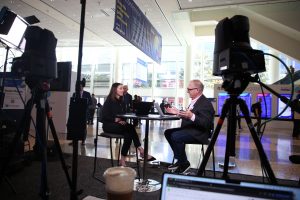This week’s RSA Conference has featured a flurry of discussions that underscore a central theme: the intersection of artificial intelligence and security.
TheCUBE is on site to analyze day 2 events, as attendees seek to grasp the implications of AI for their security strategies.
“We have to deal with the prompt security and all these sorts of things which people don’t normally have a clue about,” said David Linthicum (pictured, right), principal analyst at theCUBE Research. “We’re normally encrypting, we’re protecting, we’re building firewalls around things when something can be attacked from within. It has to have internal security that’s a different way of thinking. I think people are looking to transform their thinking.”
Linthicum spoke with Shelly Kramer (left), managing director and principal analyst at theCUBE Research, during the day 2 kickoff analysis at the RSA Conference, during an exclusive broadcast on theCUBE, SiliconANGLE Media’s livestreaming studio. They discussed the key insights and the upcoming discussions from day two of the conference, exploring how AI and cybersecurity intersect and the critical need for collaboration, strategic planning and foresight in safeguarding digital ecosystems. (* Disclosure below.)

Shelly Kramer and David Linthicum talk AI and security at RSAC.
The quest for knowledge and collaboration
The conversations at RSA underscored a fundamental shift in mindset, as organizations grapple with the imperative to transform the approach to security. Gone are the days of relying solely on perimeter defenses and traditional encryption methods. Instead, there’s a growing recognition of the need for internal security measures and a holistic understanding of AI’s role in fortifying digital infrastructures.
“We need to think beyond this stuff,” Linthicum said. “We talked a bit about heterogeneity and the complexity of the security solutions out there. What technologies are going to be put in place that are going to normalize and mitigate the complexity within these solutions?”
Amid the excitement surrounding AI’s potential, there lingered a note of caution regarding the need for strategic planning and risk mitigation. The rapid pace of AI innovation has spurred a sense of urgency among security leaders, driven by external pressures to adopt AI-driven solutions.
“Parts of a digital transformation journey, migrating to the cloud, those sorts of things, come with a certain amount of risk,” Kramer said. “These are life-changing risks. What we’re risking right now is access to things like our critical infrastructure and our data, our customer data, our employee data, all that sort of thing.”
Looking ahead: Navigating the AI and security frontier
The risk of rushing into AI adoption without adequate planning and oversight looms large, potentially exposing organizations to unforeseen vulnerabilities and breaches down the line. Moreover, there’s a concern that the relentless pursuit of AI-driven security solutions may divert attention and resources away from foundational security measures.
“The core question would be, are you taking core innovation that needs to occur with your base level product, which is protecting your customers now and investing it into the next generation AI stuff, which is going to protect your customers sometimes in a couple of years and sometimes never if they’re not using AI,” Linthicum said.
The RSA Conference serves as a crucible for shaping the future of AI-powered security. Beyond the buzz of excitement and anticipation at RSAC lies a sobering reality: the need for a measured, strategic approach to AI adoption. From policymakers to technology providers and end users, there’s a shared responsibility to navigate the complexities of the AI security frontier with prudence and foresight.
“I don’t think the technology may not exist from the security space is going to provide ample protection from building these systems,” Linthicum said. “That’s the risk.”
Here’s the complete video interview, part of SiliconANGLE’s and theCUBE Research’s coverage of the RSA Conference:
[embedded content]
(* Disclosure: TheCUBE is a paid media partner for the RSA Conference. Neither RSA Conference, the sponsor of theCUBE’s event coverage, nor other sponsors have editorial control over content on theCUBE or SiliconANGLE.)
Photo: SiliconANGLE
Your vote of support is important to us and it helps us keep the content FREE.
One click below supports our mission to provide free, deep, and relevant content.
Join our community on YouTube
Join the community that includes more than 15,000 #CubeAlumni experts, including Amazon.com CEO Andy Jassy, Dell Technologies founder and CEO Michael Dell, Intel CEO Pat Gelsinger, and many more luminaries and experts.
THANK YOU
This post was originally published on 3rd party site mentioned in the title of this site




